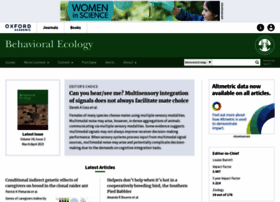Oxfordjournals - beheco.oxfordjournals.org - Behavioral Ecology - current issue

General Information:
Latest News:
Prey escorting behavior and possible convergent evolution of foraging recruitment mechanisms in an invasive ant 9 Aug 2013 | 06:04 pm
The longhorn crazy ant Paratrechina longicornis is a pest ant species with worldwide distribution. It tends honeydew-producing Hemiptera to obtain carbohydrates and is also an effective predator and s...
Differentiating among alternative models for the resolution of parent-offspring conflict 9 Aug 2013 | 06:04 pm
Understanding the behavioral mechanisms mediating the resolution of parent–offspring conflict is an important challenge given that the resolution of this conflict shapes the transfer of resources from...
When every sperm counts: factors affecting male fertility in the honeybee Apis mellifera 9 Aug 2013 | 06:04 pm
Eusocial hymenopteran males have exceptionally high levels of ejaculate quality, which are assumed to result from extreme selection pressures for pre- and postcopulatory male–male competition and the ...
Male choice of mates and mating resources in the rose bitterling (Rhodeus ocellatus) 9 Aug 2013 | 06:04 pm
The traditional view of sexual selection acting wholly through male–male competition and female choice has been challenged in recent years. An increasing body of experimental work has demonstrated a r...
Predator and prey activity levels jointly influence the outcome of long-term foraging bouts 9 Aug 2013 | 06:04 pm
Consistent interindividual differences in behavior (i.e., "behavioral types") may be a key factor in determining the outcome of species interactions. Studies that simultaneously account for the behavi...
Change in flight initiation distance between urban and rural habitats following a cold winter 9 Aug 2013 | 06:04 pm
Adaptation to proximity of humans should be particularly advantageous during adverse environmental conditions because the ability to withstand proximity to humans allows for exploitation of abundant f...
Parental effects on early development: testing for indirect benefits of polyandry 9 Aug 2013 | 06:04 pm
Females of many species mate with multiple males even when it is costly. Multiple mating may allow females to exploit postcopulatory mechanisms to ensure that their eggs are fertilized by high quality...
Foraging in groups allows collective predator detection in a mammal species without alarm calls 9 Aug 2013 | 06:04 pm
Although collective detection plays a key role in determining individual survival, few studies have carefully examined the collective process of detection. We investigated collective detection in the ...
The evolution and function of pattern diversity in snakes 9 Aug 2013 | 06:04 pm
Species in the suborder Serpentes present a powerful model for understanding processes involved in visual signal design. Although vision is generally poor in snakes, they are often both predators and ...
The effect of competitors on calling effort and life span in male field crickets 9 Aug 2013 | 06:04 pm
Temporal variation in the strength of selection on male sexual traits is often attributable to changes in the social environment that alter the number of competitors. Selection could favor phenotypic ...

